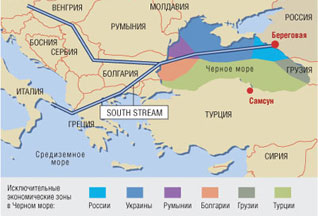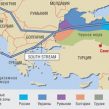
GAZPROM’S SOUTH STREAM PROJECT CAN BE HALTED IN THE BLACK SEA
Publication: Eurasia Daily Monitor Volume: 5 Issue: 43
By:

Gazprom and the Kremlin have lined up Central Asian gas commitments upstream and European Union markets downstream for the South Stream pipeline project. Russia’s project seems to enjoy an unstoppable momentum against its rival Nabucco and other Western-backed projects for Caspian gas to Europe.
Nevertheless, South Stream can be halted in the Black Sea by Ukraine and Romania on a legal basis, at no risk to themselves and with appropriate Western support, until access can be opened to Central Asian gas for Nabucco.
The grounds for halting South Stream are familiar from the debate on the merits of EU- and U.S.-backed Nabucco versus Gazprom’s rival project. If South Stream is actually built, it would, inter alia:
1) monopolize markets in central and southeastern Europe, including EU member countries, while significantly expanding Gazprom’s market share in West European countries;
2) lock the Russian state monopoly in, and potential competitor suppliers out, for decades to come, in parts of EU territory;
3) enable Gazprom to take over critical infrastructure in Europe as part of supply deals;
4) deeply distort market economics through price dictation on gas and other forms of energy, also forcing consumers to bear inordinately high costs of Russian-delivered gas;
5) help perpetuate Russia’s monopsony on Central Asian gas;
6) facilitate Moscow’s nascent strategy to create a cartel of gas exporters (so-called “OPEC for gas”) under Russian leadership, with Iran in tow;
7) enable Russia to control, through South Stream, the Southern Corridor gateway for Central Asian and Iranian gas to Europe in the future;
8) set the stage for Gazprom’s continuing dominance in Europe through control of transport, even after Russia’s own gas export potential declines (as is forecast) in the years ahead;
9) pose manifold risks to the integrity of political and financial systems in Europe, as already noticed in several EU member countries with non-transparent links to Gazprom and the Kremlin; and
10) expose the EU to political whims of Serbia, a South Stream transit country, enticed by Moscow into ultranationalist politics, resulting in highly problematic relations to the EU.
These and other adverse consequences of South Stream can be avoided, if the project is stopped long enough for the EU and United States to set their own defective energy security strategies in working order. This would involve opening access to Central Asian gas through direct pipelines to Europe, as well as developing Iranian gas for liquefaction and shipping to international markets.
The South Stream pipeline is designed to run from Russia’s Black Sea coast to a point near Varna in Bulgaria. In that country, South Stream would bifurcate into a southern branch via Greece to Italy and a northern branch via Serbia and Hungary to Austria. There, Gazprom is developing a major storage and transmission center for Europe near Vienna.
The pipeline’s section on the seabed of the Black Sea is the key to the entire project. Gazprom lacks the technology for building such an ultra-deep pipeline. Italy’s ENI is set opportunistically to provide that technology, as ENI did in 1999-2002 for Gazprom’s Blue Stream One pipeline on the seabed of the Black Sea from Russia to Turkey. The South Stream seabed pipeline is much longer and more challenging technologically and financially than Blue Stream One.
South Stream’s 900 kilometer seabed section is planned to traverse Ukraine’s exclusive economic zone for most of its length, as well as a small part of Romania’s exclusive economic zone. This situation can give both countries potentially decisive leverage over the project.
Ukraine and Romania are not included in the South Stream project. Ukraine is, in a sense, an intended casualty of South Stream: this project is specifically designed to bypass Ukraine and reduce the share of Russian-delivered gas to Europe through Ukrainian pipelines (one motivation being to de-capitalize Ukraine’s transit pipeline system and introduce some form of “joint” control over it). Meanwhile, Romania is the only Nabucco consortium member to have turned down Gazprom’s offer to join South Stream. The country’s President Traian Basescu and parts of the government have correctly analyzed South Stream’s disadvantages and risks.
Both countries are interested in stopping South Stream. This pipeline, if built, would kill Nabucco, thus depriving Romania of alternative gas supplies and transit revenue from the Nabucco project, to which Bucharest remains loyal. For its part, Ukraine is interested in continuing large-scale transit of Russian-delivered gas to Europe, as opposed to seeing part of that transit re-routed through South Stream.
The Black Sea does not have a “neutral” zone in the usual sense of the term. Riparian countries divide the sea into exclusive economic zones bilaterally. These maritime zones are immediately adjacent to each other. Ukraine’s economic zone abuts directly on those of Russia to the east, Turkey to the south, and Romania to the west. Romania’s and Bulgaria’s zones also border each other. Thus, construction of the South Stream pipeline on its presently designated seabed route from Russia to Bulgaria would require the consent of Ukraine and Romania.
Theoretically, Russia could build the South Stream pipeline through Turkey’s exclusive economic zone, en route to Bulgaria. However, one of Russia’s rationales behind South Stream is to bypass Turkey, just as bypassing Ukraine. The Kremlin has abandoned its earlier intentions to expand Blue Stream One on the seabed to Turkey and continue it as Blue Stream Two overland from Turkey to Europe. Instead, Moscow has chosen to circumvent Turkey through South Stream. This move avoids difficult dealings with Ankara on the terms of overland transit. It also implements Moscow’s broader strategy to switch from overland to seabed gas transit pipelines wherever possible. In this case, Russia prefers contending with the limited jurisdictions of Ukraine and Romania in their maritime economic zones, rather than the fully sovereign jurisdiction of Turkey on land.
Under international maritime law, Ukraine and Romania can not officially veto South Stream outright. But they can question it thoroughly; can demand extensive study of the project’s impact on environment, shipping and maritime safety generally; and are entitled to evaluate these studies and independently assess their findings. They are also entitled to demand modifications to the Russian-proposed route.
In the Baltic Sea last year Estonia, Finland, Poland, Sweden, and Lithuania have used their rights under international law in this manner. They have thoroughly questioned Gazprom’s Nord Stream seabed pipeline project in most of its aspects and demanded modifications of its route. As a cumulative result, Nord Stream has been temporarily halted, and its overall prospects seem increasingly clouded for intrinsic reasons also.
Russian officials such as Deputy Minister of Energy and Industry Anatoly Yanovsky and Grigory Vilchek, deputy head of Piter Gaz (involved in the Nord Stream impact studies), now recognize that the government and Gazprom have failed to initiate consultations with Ukraine and Romania about South Stream’s seabed section. Moscow seems to repeat the costly error it made when failing to hold advance consultations with Baltic Sea riparian countries about the Nord Stream seabed pipeline. Whether these errors are of omission or of commission seems unclear. What is certain is that Ukraine and Romania — similarly with the Baltic Sea countries — hold legal leverage of a potentially decisive character over seabed pipeline projects.
(Kommersant [Moscow] and Kommersant-Ukraine, Interfax February 29; www.oil.ru, www.iamik.ru, March 3)




